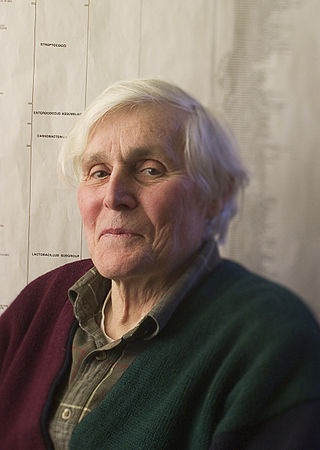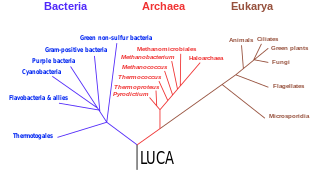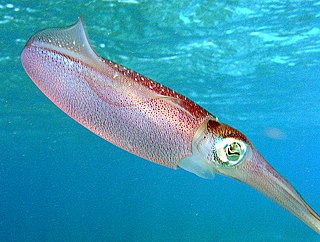Related Research Articles

Carl Richard Woese was an American microbiologist and biophysicist. Woese is famous for defining the Archaea in 1977 through a pioneering phylogenetic taxonomy of 16S ribosomal RNA, a technique that has revolutionized microbiology. He also originated the RNA world hypothesis in 1967, although not by that name. Woese held the Stanley O. Ikenberry Chair and was professor of microbiology at the University of Illinois Urbana–Champaign.
In biology, a kingdom is the second highest taxonomic rank, just below domain. Kingdoms are divided into smaller groups called phyla.
In biological taxonomy, a domain, also dominion, superkingdom, realm, or empire, is the highest taxonomic rank of all organisms taken together. It was introduced in the three-domain system of taxonomy devised by Carl Woese, Otto Kandler and Mark Wheelis in 1990.

The three-domain system is a biological classification introduced by Carl Woese, Otto Kandler, and Mark Wheelis in 1990 that divides cellular life forms into three domains, namely Archaea, Bacteria, and Eukarya. The key difference from earlier classifications such as the two-empire system and the five-kingdom classification is the splitting of Archaea from Bacteria as completely different organisms. It has been challenged by the two-domain system that divides organisms into Bacteria and Archaea only, as Eukaryotes are considered as one group of Archaea.

Horizontal gene transfer (HGT) or lateral gene transfer (LGT) is the movement of genetic material between organisms other than by the ("vertical") transmission of DNA from parent to offspring (reproduction). HGT is an important factor in the evolution of many organisms. HGT is influencing scientific understanding of higher order evolution while more significantly shifting perspectives on bacterial evolution.

The Thermoproteota are prokaryotes that have been classified as a phylum of the Archaea domain. Initially, the Thermoproteota were thought to be sulfur-dependent extremophiles but recent studies have identified characteristic Thermoproteota environmental rRNA indicating the organisms may be the most abundant archaea in the marine environment. Originally, they were separated from the other archaea based on rRNA sequences; other physiological features, such as lack of histones, have supported this division, although some crenarchaea were found to have histones. Until recently all cultured Thermoproteota had been thermophilic or hyperthermophilic organisms, some of which have the ability to grow at up to 113°C. These organisms stain Gram negative and are morphologically diverse, having rod, cocci, filamentous and oddly-shaped cells.

Lophotrochozoa is a clade of protostome animals within the Spiralia. The taxon was established as a monophyletic group based on molecular evidence. The clade includes animals like annelids, molluscs, bryozoans, brachiopods, and platyhelminthes.
The Shine–Dalgarno (SD) sequence is a ribosomal binding site in bacterial and archaeal messenger RNA, generally located around 8 bases upstream of the start codon AUG. The RNA sequence helps recruit the ribosome to the messenger RNA (mRNA) to initiate protein synthesis by aligning the ribosome with the start codon. Once recruited, tRNA may add amino acids in sequence as dictated by the codons, moving downstream from the translational start site.

The last universal common ancestor (LUCA) is hypothesized to have been a common ancestral cell from which the three domains of life, the Bacteria, the Archaea, and the Eukarya originated. It is suggested to have been a "cellular organism that had a lipid bilayer and used DNA, RNA, and protein". In general, the LUCA is considered the point or stage at which the domains of life diverged from the precursing forms of life. The nature of this point or stage of divergence remains a topic of research.
Viral eukaryogenesis is the hypothesis that the cell nucleus of eukaryotic life forms evolved from a large DNA virus in a form of endosymbiosis within a methanogenic archaeon or a bacterium. The virus later evolved into the eukaryotic nucleus by acquiring genes from the host genome and eventually usurping its role. The hypothesis was first proposed by Philip Bell in 2001 and was further popularized with the discovery of large, complex DNA viruses that are capable of protein biosynthesis.

Neomura is a possible clade composed of the two domains of life of Archaea and Eukaryota. The group was named by Thomas Cavalier-Smith in 2002. Its name means "new walls", reflecting his hypothesis that it evolved from Bacteria, and one of the major changes was the replacement of peptidoglycan cell walls with other glycoproteins. As of August 2017, the neomuran hypothesis is not accepted by most workers; molecular phylogenies suggest that eukaryotes are most closely related to one group of archaeans and evolved from them, rather than forming a clade with all archaeans, and that Archaea and Bacteria are sister groups.

A prokaryote is a single-celled organism that lacks a nucleus and other membrane-bound organelles. The word prokaryote comes from the Ancient Greek πρό 'before' and κάρυον 'nut, kernel'. In the two-empire system arising from the work of Édouard Chatton, prokaryotes were classified within the empire Prokaryota. But in the three-domain system, based upon molecular analysis, prokaryotes are divided into two domains: Bacteria and Archaea. Organisms with nuclei are placed in a third domain, Eukaryota. Prokaryotes evolved before eukaryotes.

Archaea is a domain of single-celled organisms. These microorganisms lack cell nuclei and are therefore prokaryotes. Archaea were initially classified as bacteria, receiving the name archaebacteria, but this term has fallen out of use.

The Spiralia are a morphologically diverse clade of protostome animals, including within their number the molluscs, annelids, platyhelminths and other taxa. The term Spiralia is applied to those phyla that exhibit canonical spiral cleavage, a pattern of early development found in most members of the Lophotrochozoa.

Scientists trying to reconstruct evolutionary history have been challenged by the fact that genes can sometimes transfer between distant branches on the tree of life. This movement of genes can occur through horizontal gene transfer (HGT), scrambling the information on which biologists relied to reconstruct the phylogeny of organisms. Conversely, HGT can also help scientists to reconstruct and date the tree of life. Indeed, a gene transfer can be used as a phylogenetic marker, or as the proof of contemporaneity of the donor and recipient organisms, and as a trace of extinct biodiversity.

The eukaryotes constitute the domain of Eukarya, organisms whose cells have a membrane-bound nucleus. All animals, plants, fungi, and many unicellular organisms are eukaryotes. They constitute a major group of life forms alongside the two groups of prokaryotes: the Bacteria and the Archaea. Eukaryotes represent a small minority of the number of organisms, but due to their generally much larger size, their collective global biomass is much larger than that of prokaryotes.
Evolution of cells refers to the evolutionary origin and subsequent evolutionary development of cells. Cells first emerged at least 3.8 billion years ago approximately 750 million years after Earth was formed.
Bacterial taxonomy is subfield of taxonomy devoted to the classification of bacteria specimens into taxonomic ranks.

The eocyte hypothesis in evolutionary biology proposes that the eukaryotes originated from a group of prokaryotes called eocytes. After his team at the University of California, Los Angeles discovered eocytes in 1984, James A. Lake formulated the hypothesis as "eocyte tree" that proposed eukaryotes as part of archaea. Lake hypothesised the tree of life as having only two primary branches: Parkaryoates that include Bacteria and Archaea, and karyotes that comprise Eukaryotes and eocytes. Parts of this early hypothesis were revived in a newer two-domain system of biological classification which named the primary domains as Archaea and Bacteria.

The two-domain system is a biological classification by which all organisms in the tree of life are classified into two big domains, Bacteria and Archaea. It emerged from development in the knowledge of archaea diversity and challenge over the widely accepted three-domain system that defines life into Bacteria, Archaea, and Eukarya. It was predicted by the eocyte hypothesis of James A. Lake in the 1980s, which was largely superseded by the three-domain system due to better compelling evidences at the time. Better understanding of archaea, especially in their roles in the origin of eukaryotes by symbiogenesis with bacteria, led to the revival of the eocyte hypothesis in the 2000s. The two-domain system became widely appreciated after the discovery of a large group (superphylum) of archaea called Asgard in 2017, evidences of which suggest to be the evolutionary root of eukaryotes – implying that eukaryotes are members of the domain Archaea.
References
- ↑ "James A Lake CURRICULUM VITAE" (PDF). Retrieved 2011-07-01.
- ↑ Zimmer, C. (2009). "On the Origin of Eukaryotes". Science. 325 (5941): 666–668. doi:10.1126/science.325_666. PMID 19661396.
- ↑ Lake, J. A. (2009). "Evidence for an early prokaryotic endosymbiosis". Nature. 460 (7258): 967–971. Bibcode:2009Natur.460..967L. doi:10.1038/nature08183. PMID 19693078. S2CID 4413304.
- ↑ Lake, J. A.; Skophammer, R. G.; Herbold, C. W.; Servin, J. A. (2009). "Genome beginnings: Rooting the tree of life". Philosophical Transactions of the Royal Society B: Biological Sciences. 364 (1527): 2177–2185. doi:10.1098/rstb.2009.0035. PMC 2873003 . PMID 19571238.
- ↑ "The Darwin-Wallace Medal". The Linnean Society of London. Retrieved 28 February 2018.
- ↑ Rivera, M.C.; Jain, R.; Moore, J. E.; Lake, J.A. (1998). "Genomic Evidence for two functionally distinct gene classes". Proc. Natl. Acad. Sci. USA. 95 (11): 6239–6244. Bibcode:1998PNAS...95.6239R. doi: 10.1073/pnas.95.11.6239 . PMC 27643 . PMID 9600949.
- ↑ Jain, R; Rivera, MC; Lake, JA (March 1999). "Horizontal gene transfer among genomes: The complexity hypothesis". Proceedings of the National Academy of Sciences. 96 (7): 3801–3806. Bibcode:1999PNAS...96.3801J. doi: 10.1073/pnas.96.7.3801 . PMC 22375 . PMID 10097118.
- ↑ Lake, J.A.; Servin, J.A.; Herbold, C.W.; Skophammer, R.G. (2008). "Evidence for a new root of the tree of life". Syst Biol. 57 (6): 835–843. doi: 10.1080/10635150802555933 . PMID 19085327.
- ↑ Lake, J. A. (1990). "Origin of the Metazoa". Proceedings of the National Academy of Sciences of the United States of America. 87 (2): 763–766. Bibcode:1990PNAS...87..763L. doi: 10.1073/pnas.87.2.763 . PMC 53346 . PMID 2300560.
- ↑ Garey, J. (2001). "Ecdysozoa: The Relationship between Cycloneuralia and Panarthropoda". Zoologischer Anzeiger. 240 (3–4): 321–330. doi:10.1078/0044-5231-00039.
- ↑ Halanych, K. M.; Bacheller, J. D.; Aguinaldo, A. M.; Liva, S. M.; Hillis, D. M.; Lake, J. A. (1995). "Evidence from 18S ribosomal DNA that the lophophorates are protostome animals". Science. 267 (5204): 1641–1643. Bibcode:1995Sci...267.1641H. doi:10.1126/science.7886451. PMID 7886451. S2CID 12196991.
- ↑ Aguinaldo, A. M. A.; Turbeville, J. M.; Linford, L. S.; Rivera, M. C.; Garey, J. R.; Raff, R. A.; Lake, J. A. (1997). "Evidence for a clade of nematodes, arthropods and other moulting animals". Nature. 387 (6632): 489–493. Bibcode:1997Natur.387R.489A. doi:10.1038/387489a0. PMID 9168109. S2CID 4334033.
- ↑ Cox, C. J.; Foster, P. G.; Hirt, R. P.; Harris, S. R.; Embley, T. M. (2008). "The archaebacterial origin of eukaryotes" (PDF). Proceedings of the National Academy of Sciences. 105 (51): 20356–20361. Bibcode:2008PNAS..10520356C. doi: 10.1073/pnas.0810647105 . PMC 2629343 . PMID 19073919.
- ↑ Lake, J. A.; Henderson, E.; Oakes, M.; Clark, M. W. (1984). "Eocytes: A new ribosome structure indicates a kingdom with a close relationship to eukaryotes". Proceedings of the National Academy of Sciences of the United States of America. 81 (12): 3786–3790. Bibcode:1984PNAS...81.3786L. doi: 10.1073/pnas.81.12.3786 . PMC 345305 . PMID 6587394.
- ↑ Lake, J. A. (1988). "Origin of the eukaryotic nucleus determined by rate-invariant analysis of rRNA sequences". Nature. 331 (6152): 184–186. Bibcode:1988Natur.331..184L. doi:10.1038/331184a0. PMID 3340165. S2CID 4368082.
- ↑ Rivera, M. C.; Lake, J. A. (1992). "Evidence that eukaryotes and eocyte prokaryotes are immediate relatives". Science. 257 (5066): 74–76. Bibcode:1992Sci...257...74R. doi:10.1126/science.1621096. PMID 1621096.
- ↑ Tourasse, N.; Gouy, M. (1999). "Accounting for Evolutionary Rate Variation among Sequence Sites Consistently Changes Universal Phylogenies Deduced from rRNA and Protein-Coding Genes". Molecular Phylogenetics and Evolution. 13 (1): 159–168. doi:10.1006/mpev.1999.0675. PMID 10508549.